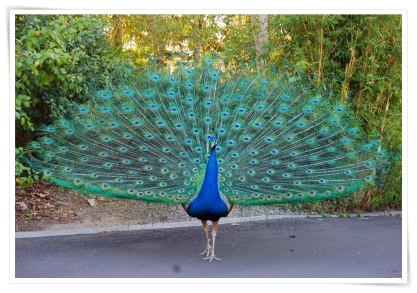
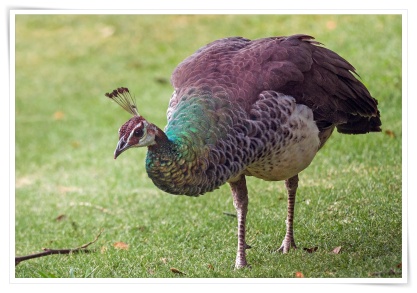
- Kingdom: Animalia
- Phylum: Chordata
- Class: Aves
- Order : Galliformes
- Family: Phasianidae
- Genus: Pavo
- Species: cristatus
- English Name: Indian peafowl
- Scientific Name: Pavo cristatus
- Distribution:In India: – but roam all throughout South Asia, Pakistan, Bhutan, Nepal and Sri Lanka. Peafowl also have been brought to Singapore, Australia, New Zealand, Florida and the Bahamas and do well there.(Myanmar)
- General Description :
The Indian peafowl (Pavo cristatus), also known as the common peafowl, and blue peafowl. Its loud calls make it easy to detect, and in forest areas often indicates the presence of a predator such as a tiger. The bird is celebrated in Hindu and Greek mythology and is the national bird of India.
- Size: Male: 100 – 120 cm ,Female: 95 cm (Adult)
- Weight: Male: 4 – 6 kg (Adult), Female: 2.8 – 4 kg (Adult).
- Food in Zoo:Poultry Feed, Bird Mesh,Onion, Garlic,Paddy, Chopped Spinach
- Sexual Maturity: 2 -3 years.
- Incubation Period: 28 to 30 Days.
- Average Life Span: Average life span 10 to 25 years.
- Conservation Status: The IUCN lists the Green Peafowl as vulnerable to extinction due to hunting and a reduction in extent and quality of habitat.
- CITES: Appendix III
- WPA 1972: Schedule I
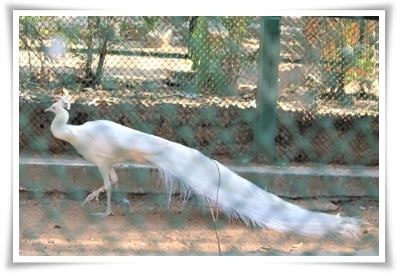

- Kingdom: Animalia
- Phylum: Chordata
- Class: Aves
- Order: Galliformes
- Family: Phasianidae
- Genus: Pavo
- Species: cristatus
- English Name: White peafowls
- Scientific Name: Pavo cristatus.
- Distribution:White peafowls are not found in the wild.
- General Description :
The white Peacock is not different than the Peacocks. It’s not a Species of peacock; it is a special peacock that has been born all white, due to a genetic variation. White peacocks are not albino. Albino animals have a complete lack of color and red or pink eyes, and albino skin is very pale. White peafowl have blue eyes and colored skin.
- Size: Male: 100 – 120 cm ,Female: 95 cm (Adult)
- Weight: Male: 4 – 6 kg (Adult), Female: 2.8 – 4 kg (Adult).
- Food in Zoo: Poultry Feed, Bird Mesh, Onion, Garlic, Paddy, Chopped spinach.
- Sexual Maturity: 2 -3 years
- Incubation Period:28 to 30 Days.
- Average Life Span: Average life span 10 to 25 years.
- Conservation Status:IUCN : Least Concern (LC)CITES: Appendix IIIWPA 1972: Schedule I
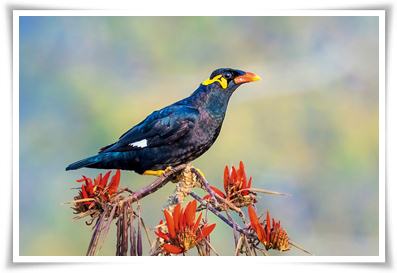

- Kingdom: Animalia
- Phylum: Chordata
- Class: Aves
- Order: Passeriformes
- Family: Sturnidae
- Genus: Gracula
- Species: religiosa
- English Name: Common Hill Mynah
- Scientific Name: Gracula religiosa.
- Distribution:Bhutan; Brunei Darussalam; Cambodia; China; India; Indonesia; Lao People's Democratic Republic; Malaysia; Myanmar; Nepal; Philippines; Singapore; Thailand; Viet Nam; Bangladesh
- General Description :
The common hill myna, sometimes spelled “mynah” and formerly simply known as the hill myna or myna bird, is the myna most commonly seen in aviculture, where it is often simply referred to by the latter two names. It is a member of the starling Family, resident in hill regions of South Asia and Southeast Asia. - Size: 28-30 cm.
- Weight: 200-250 gm
- Food in Zoo: Ripe Banana, Papaya, Chana Sattu.
- Sexual Maturity: 9-12 months
- Incubation Period: 17-18 Days.
- Average Life Span: about 8-12 years.
- Conservation Status: IUCN : Least Concern (LC)CITES: Appendix IIWPA 1972: Schedule I

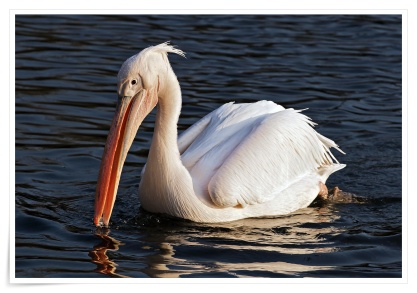
- Kingdom: Animalia
- Phylum: Chordata
- Class: Aves
- Order: Pelecaniformes
- Family: Pelecanidae
- Genus: Pelecanus
- Species: onocrotalus
- English Name: Great White Pelican
- Scientific Name: Pelecanus onocrotalus
- Distribution:The spot-billed pelican (Pelecanus philippensis) or grey pelican, is a member of the pelican Family. It breeds in southern Asia from southern Pakistan across India east to Indonesia
- General Description :
Light Pelican Grey. Light Pelican Grey is a pale, warm, mauve gray with a magenta undertone. It is a perfect paint color for a serene and soothing room. Pair it with darker gray tones. - Size: 140-180 cm
- Weight: 5-15 kg.
- Food in Zoo: Small Fish
- Sexual Maturity: 3-4 years.
- Incubation Period: 29 to 36 days
- Average Life Span: 10 to 25 years.
- Conservation Status: IUCN : Least Concern (LC)CITES: Not ListedWPA 1972: Schedule IV

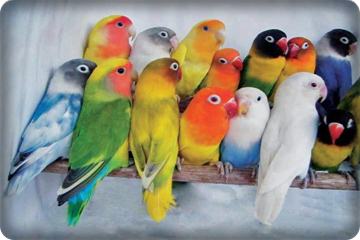
- Kingdom: Animalia
- Phylum: Chordata
- Class: Aves
- Order: Psittaciformes
- Family: Psittacidae
- Genus: Agapornis.
- Species: sps.
- English Name: Love Birds
- Scientific Name: Agapornis sps
- Distribution:These birds live across Africa, and one Species lives in Madagascar. The range of each bird is different, and some Species live across larger areas, while others live in a restricted location. Some of the different regions of Africa that they live in include Tanzania, Malawi, Zambia, Botswana, South Africa, Namibia, Ethiopia, and more.
- General Description :
: Lovebird is the common name for the genus Agapornis, a small group of parrots in the Old World parrot family Psittaculidae. Social and affectionate, the name comes from the parrots' strong, monogamous pair bonding and the long periods which paired birds spend sitting together. Lovebirds live in small flocks and eat fruit, vegetables, grasses, seeds and insects.
- Size:Lovebirds are 13 to 17 cm in length, up to 24 cm in wingspan with 9 cm
- Weight: 40 to 60 gm
- Food in Zoo: Bird Mesh, Chopped Spinach
- Sexual Maturity: 10-12 months.
- Incubation Period: 21 to 23 days.
- Average Life Span: 10-15 years
- Conservation Status: IUCN : Least Concern (LC)
CITES: Appendix II
WPA 1972: Schedule IV


- Kingdom: Animalia
- Phylum: Chordata
- Class: Aves
- Order: Accipitriformes
- Family: Accipitridae
- Genus: Milvus
- Species: migrans
- English Name: Black Kite/ Common Pariah Kite
- Scientific Name: Milvus migrans
- Distribution:The species is found in Europe, Asia, Africa and Australia.
- General Description :
The Black kite (Milvus migrans) is a medium-sized bird of prey in the family Accipitridae, which also includes many other diurnal raptors. It is thought to be the world's most abundant species of Accipitridae. Unlike others in the group, Black kites are opportunistic hunters and spend much time soaring and gliding in thermals in search of food. Their angled wing and distinctive forked tail make them easy to identify. They are also vociferous with a shrill whinnying call. - Size: : Length 48–58 cm (19–23 in), wingspan 130–155 cm (51–60 in).
- Weight: 560–940 g (22–38 oz).
- Food in Zoo:Chicken Meat
- Sexual Maturity: 2 – 3 years.
- Incubation Period: 30 – 34 Days.
- Average Life Span: average life span 22 years
- Conservation Status: IUCN : Least Concern (LC)CITES: Appendix IIWPA 1972: Not Listed
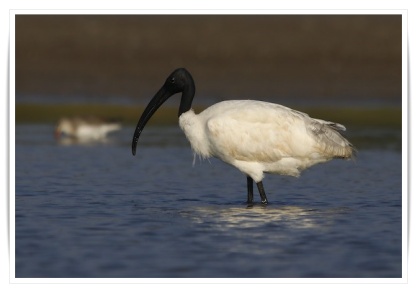
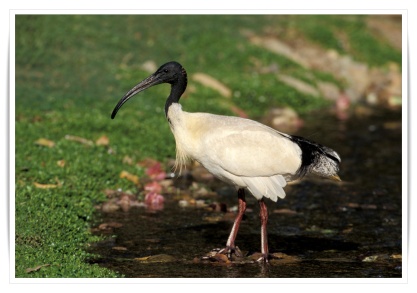
- Kingdom: Animalia
- Phylum: Chordata
- Class: Aves
- Order: Pelecaniformes
- Family: Threskiornithidae
- Genus: Threskiornis
- Species: melanocephalus
- English Name:White Ibis/Black-headed Ibis
- Scientific Name:Threskiornis melanocephalus
- Distribution:: India; Indonesia; Russian Federation (Eastern Asian Russia), Extant (breeding);Cambodia; Pakistan; Sri Lanka; Viet Nam,Extant (non-breeding);Bangladesh; China; Hong Kong; Malaysia; Myanmar; Nepal; Philippines; Thailand
New Guinea: Papuan eagle, white-bellied sea-eagle, pygmy eagle - General Description :
The black-headed ibis (Threskiornis melanocephalus), also known as the Oriental white ibis, Indian white ibis, and black-necked ibis. It is the only native ibis Species in its range that has an overall white plumage with a black neck and head. The down-curved beak and legs are also black. Though often referred to as a wetland Species, the black-headed ibis forages in a range of natural and man-made habitats. This Species of ibis nests only during the rainy season (or monsoon). - Size:65-75 cm
- Weight: 1.4 - 2.5 kg
- Food in Zoo:Fish
- Sexual Maturity: 1-5 years
- Incubation Period: 23-25 days
- Average Life Span:about 28 years
- Conservation Status:IUCN : Near Threatened (NT) CITES: Not ListedWPA 1972: Scheduled IV

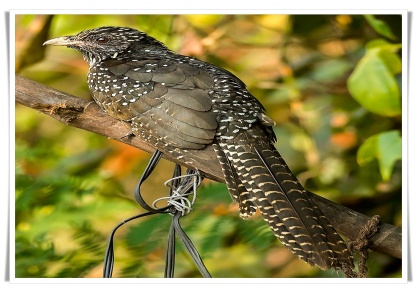
- Kingdom: Animalia
- Phylum: Chordata
- Class: Aves
- Order: Cuculiformes
- Family: Cuculidae
- Genus:Eudynamys
- Species: scolopaceus
- English Name: Asian Koel
- Scientific Name: Eudynamys scolopaceus
- Distribution:In India- It is a mainly resident breeder in tropical southern Asia from Pakistan, India, Bangladesh and Sri Lanka to southern China and the Greater Sundas
- General Description :
The Asian koel (Eudynamysscolopaceus) is a member of the cuckoo Order of birds, the Cuculiformes. The Asian koel like many of its related cuckoo kin is a brood parasite that lays its eggs in the nests of crows and other hosts, who raise its young. The name koel is echoic in origin with several language variants. The bird is a widely used symbol in Indian and Nepali poetry. - Size: 39–46 cm (15–18 in)
- Weight: 190–327 gm.
- Food in Zoo:Ripe Banana, Chana Sattu, Papaya, Paddy
- Sexual Maturity: 2-3 years
- Incubation Period: 12 to 14 days.
- Average Life Span: average life span 12 to 15 years.
- Conservation Status:IUCN : Least Concern (LC) CITES: Not Listed
WPA 1972: Not Listed
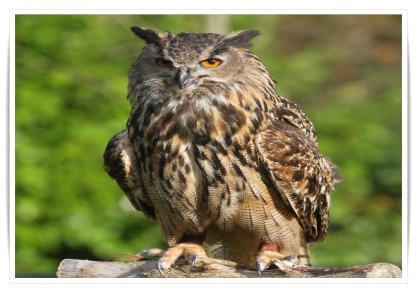
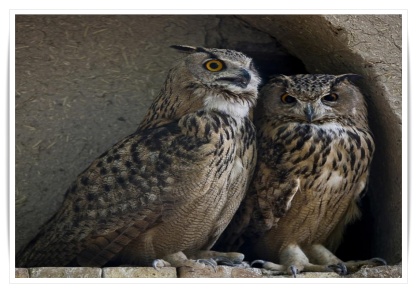
- Kingdom: Animalia
- Phylum: Chordata
- Class: Aves
- Order: Strigiformes
- Family: Strigidae
- Genus: Bubo
- Species: bubo
- English Name:Eurasian Eagle-owl
- Scientific Name: Bubo bubo.
- Distribution:Eurasian Eagle-owls are found throughout much of Europe and Asia and in parts of northern Africa
- General Description :
Owls are birds from the order Strigiform, which includes about 200 species of mostly solitary and nocturnal birds of prey typified by an upright stance, a large, broad head, binocular vision, binaural hearing, sharp talons, and feathers adapted for silent flight. - Size: 56 to 75 cm (22 to 30 in)
- Weight: Females 1.75 to 4.6 kg and males 1.22 to 3.2 kg.
- Food in Zoo: Chicken Meat, day old Chicks
- Sexual Maturity: 2 – 3 years.
- Incubation Period: 31-36 Days.
- Average Life Span: 10 - 20 years.
- Conservation Status: IUCN : Least Concern (LC)CITES: Appendix IIWPA 1972: Schedule III


- Kingdom: Animalia
- Phylum: Chordata
- Class: Aves
- Order: Struthioniformes
- Family: Casuariidae
- Genus: Dromaius
- Species: novaehollandiae
- English Name: Common Emu
- Scientific Name: Dromaius novaehollandiae
- Distribution:Australia
- General Description :
Emus are soft-feathered, brown, flightless birds with long necks and legs, and can reach up to 1.9 metres (6.2 ft) in height. Emus can travel great distances, and when necessary can sprint at 50 km/h (31 mph); they forage for a variety of plants and insects, but have been known to go for weeks without eating. They drink infrequently, but take in copious amounts of water when the opportunity arises. - Size: 1.8 metre.
- Weight: 18 and 60 kg.
- Food in Zoo: Poultry Feed, Chopped Spinach, Apple, Onion, Ripe Banana, Papaya
- Sexual Maturity: 2 – 3 years.
- Incubation Period: 56 Days.
- Average Life Span:average life span 10 years.
- Conservation Status: IUCN : Least Concern (LC)CITES: Not Listed
WPA 1972: Not Listed
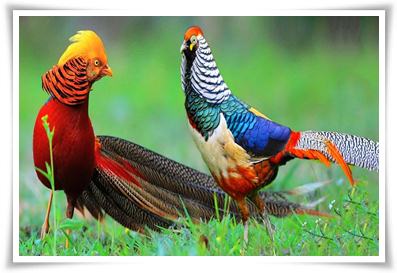

- Kingdom: Animalia
- Phylum: Chordata
- Class: Aves
- Order: Galliformes
- Family: Phasianidae
- Genus: Chrysolophus
- Species: pictus
- English Name: Golden Pheasant
- Scientific Name: Chrysolophus pictus
- Distribution:: China & United Kingdom
- General Description :
The golden pheasant (Chrysolophus pictus), also known as the Chinese pheasant, and rainbow pheasant. It is unmistakable with its golden crest and rump and bright red body. The deep orange "cape" can be spread in display, appearing as an alternating black and orange fan that covers all of the face except its bright yellow eye with a pinpoint black pupil. Males have a golden-yellow crest with a hint of red at the tip. The face, throat, chin, and the sides of neck are rusty tan. - Size: The adult male is 90–105 cm (35–41 in) in length, female shorter tail (half her 60–80 cm (24–31 in) length).
- Weight: 350-700 gm
- Food in Zoo: Poultry Feed, Grains, Paddy, Garlic, Chopped Spinach
- Sexual Maturity: Male 2 years, female 1 year.
- Incubation Period: 22 to 23 days.
- Average Life Span: 5 – 6 years,15 – 20 years under human care
- Conservation Status: IUCN : Least Concern (LC)
CITES: Not Listed
WPA 1972: Not Listed
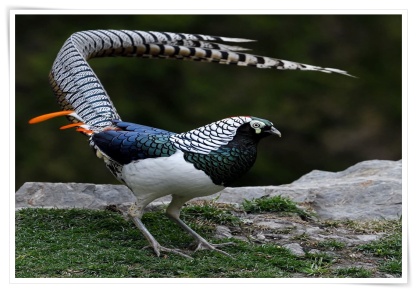
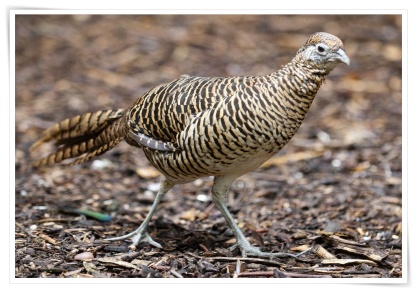
- Kingdom: Animalia
- Phylum: Chordata
- Class: Aves
- Order: Galliformes
- Family: Phasianidae
- Genus: Chrysolophus
- Species: amherstiae
- English Name:Lady Amherst's Pheasant
- Scientific Name: Chrysolophus amherstiae
- Distribution:China & Myanmar
- General Description :
Lady Amherst's pheasant (Chrysolophus amherstiae) is a bird of the Order Galliformes and the Family Phasianidae. The female is much less showy, with a duller mottled brown plumage all over, similar to that of the female common pheasant (P. colchicus) but with finer barring. Despite the male's showy appearance, these birds are very difficult to see in their natural habitat, which is dense, dark forests with thick undergrowth. Consequently, little is known of their behaviour in the wild. - Size: 100-120 cm
- Weight: 1.2 – 2 kg
- Food in Zoo:Seeds/ Paddy, Pulse, Grains, Chopped Spinach
- Sexual Maturity:about 2 years
- Incubation Period: around 22 days
- Average Life Span: around 6-10 years
- Conservation Status:IUCN : Least Concern (LC) CITES: Not Listed
WPA 1972: Not Listed
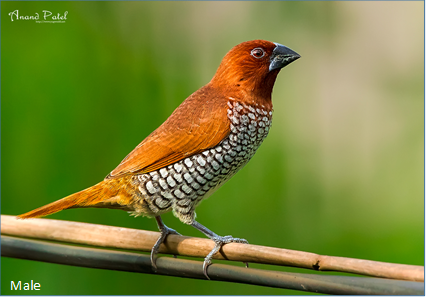
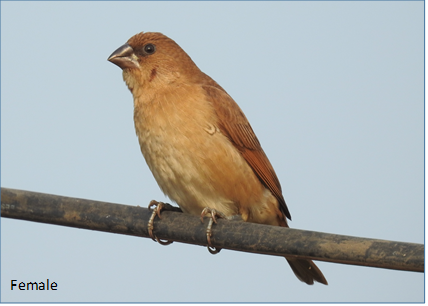
- Kingdom: Animalia
- Phylum: Chordata
- Class: Aves
- Order: Passeriformes
- Family: Estrildidae
- Genus: Lonchura
- Species: punctulata
- English Name: Scaly-breasted Munia
- Scientific Name: Lonchura punctulata
- Distribution:: Bangladesh; Brunei Darussalam; Cambodia; China; India; Indonesia; Lao People's Democratic Republic; Malaysia; Myanmar; Nepal; Sri Lanka; Taiwan, Province of China; Thailand; Timor-Leste; Viet Nam
- General Description :
The scaly-breasted munia or spotted munia (Lonchura punctulata), known in the pet trade as nutmeg mannikin or spice finch, is a sparrow-sized estrildid finch native to tropical Asia. Its name is based on the distinct scale-like feather markings on the breast and belly. The adult is brown above and has a dark conical bill. - Size:11-12 cm
- Weight: 12-16 gm
- Food in Zoo: Seeds/ Paddy, Pulse, Grains, Chopped Spinach
- Sexual Maturity: about 7 months
- Incubation Period: about 14 days
- Average Life Span: 6-8 years
- Conservation Status: IUCN : Least Concern (LC)CITES: Not ListedWPA 1972: Schedule IV
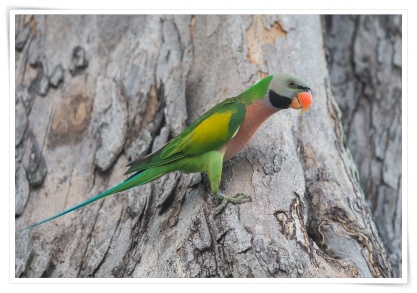

- Kingdom: Animalia
- Phylum: Chordata
- Class: Aves
- Order: Psittaciformes
- Family: Psittacidae
- Genus: Psittacula
- Species: alexandri
- English Name: Red-breasted Parakeet
- Scientific Name: Psittacula alexandri.
- Distribution:Bangladesh; Bhutan; Cambodia; China; India; Indonesia; Lao People's Democratic Republic; Myanmar; Nepal; Thailand; Viet Nam
- General Description :
The red-breasted parakeet (Psittacula alexandri) is among the more widespread Species of the Genus and is the Species which has the most geographical variations. It is easily identified by the large red patch on its breast. An alternative name is the moustached parakeet depending on sub species. Some of the island races may be threatened by the wild bird trade. The nominate race, which occurs in Java, is close to extinction. - Size: 33-38 cm in length.
- Weight: 133-168 grams
- Food in Zoo: Ripe Banana, Guava Apple, Chana Sattu, Sunflower seeds
- Sexual Maturity:2-3 years.
- Incubation Period: 23-28 days.
- Average Life Span: 20-25 years
- Conservation Status:IUCN : Near Threatened (NT) CITES: Appendix II
WPA 1972: Schedule IV
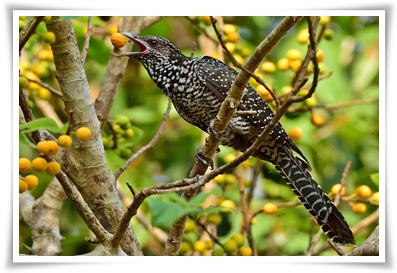
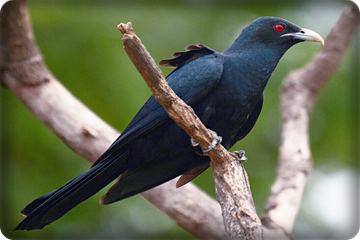
- Kingdom: Animalia
- Phylum: Chordata
- Class: Aves
- Order: Cuculiformes
- Family: Cuculidae
- Genus: Eudynamys
- Species: scolopaceus
- English Name: Asian Koel
- Scientific Name: Eudynamys scolopaceus
- Distribution:In India- It is a mainly resident breeder in tropical southern Asia from Pakistan, India, Bangladesh and Sri Lanka to southern China and the Greater Sundas
- General Description :
The Asian koel (Eudynamysscolopaceus) is a member of the cuckoo Order of birds, the Cuculiformes. It is found in the Indian Subcontinent, China, and Southeast Asia. … The Asian koel like many of its related cuckoo kin is a brood parasite that lays its eggs in the nests of crows and other hosts, who raise its young. - Size: 39–46 cm (15–18 in)
- Weight: 190–327 gm.
- Food in Zoo:Ripe Banana, Chana Sattu, Papaya, Paddy
- Sexual Maturity: 2-3 years
- Incubation Period: 12 to 14 days.
- Average Life Span: average life span 12 to 15 years
- Conservation Status:IUCN : Least Concern (LC)CITES: Not ListedWPA 1972: Not Listed

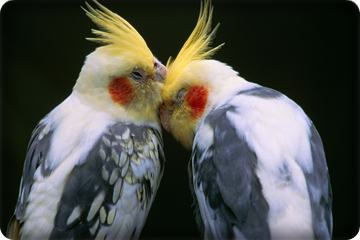
- Kingdom: Animalia
- Phylum: Chordata
- Class: Aves
- Order: Psittaciformes
- Family: Cacatuidae
- Genus: Nymphicus
- Species: hollandicus
- English Name: Cockatiel
- Scientific Name:Nymphicus hollandicus.
- Distribution:Cockatiels are native to Australia
- General Description :
Cockatiels are native to the semi-arid regions of Australia. Wild cockatiels fly to the ground to forage for food. Its plumage is mostly grey, paler below, with a white wing patch, orange cheeks and a distinctive pointed crest. The male can be identified by its bright yellow forehead, face and crest. - Size: 30 to 35 cm (12 to 13 in).
- Weight: 70 to 120 grams.
- Food in Zoo: Banana, Apple, Gram & Spinach.
- Sexual Maturity: around 15-24 months.
- Incubation Period: 18 days.
- Average Life Span: Up to 20 years in captivity, 12-15 years in wild.
- Conservation Status: IUCN :Least Concern (LC),CITES :Not Listed,WPA 1972 :Not Listed
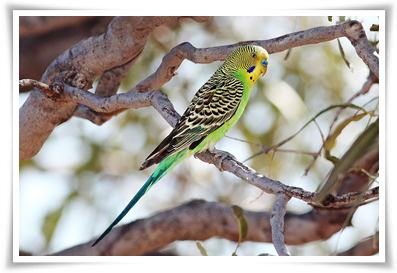

- Kingdom: Animalia
- Phylum: Chordata
- Class: Aves
- Order: Psittaciformes
- Family: Psittacidae
- Genus: Melopsittacus
- Species: undulatus
- English Name:Budgeriger
- Scientific Name: Melopsittacus undulatus
- Distribution:It is found wild throughout the drier parts of Australia,
- General Description :
The budgerigar is a long-tailed, seed-eating parrot usually nicknamed the budgie, or in American English, the parakeet. Budgies are the only Species in the Genus Melopsittacus. Naturally, the Species is green and yellow with black, scalloped markings on the nape, back, and wings. - Size: 18 cm (Adult, In the wild).
- Weight: 30 – 40 g (Adult, In the wild).
- Food in Zoo:Bird Mesh, Chopped Spinach.
- Sexual Maturity: 6-10 months.
- Incubation Period:18-20 Days.
- Average Life Span: 5 – 10 years (In captivity)
- Conservation Status: Least Concern. IUCN : Least Concern (LC)
CITES: Not Listed
WPA 1972: Not Listed


- Kingdom: Animalia
- Phylum: Chordata
- Class: Aves
- Order: Anseriformes
- Family: Anatidae
- Genus: Tadorna
- Species: ferruginea
- English Name:Ruddy shelduck or Brahminy Duck (India)
- Scientific Name: Tadorna ferruginea
- Distribution:Algeria; Armenia; Azerbaijan; Bangladesh; Bulgaria; China; Egypt; Ethiopia; Greece; India; Iran, Islamic Republic of; Iraq; Israel; Korea, Republic of; Kuwait; Lao People's Democratic Republic; Libya; Moldova; Nepal; Oman; Pakistan; Romania; Russian Federation (European Russia);
- General Description :
The Ruddy Shelduck known in India as the Brahminy duck. It has orange-brown body plumage with a paler head, while the tail and the flight feathers in the wings are black, contrasting with the white wing-coverts. The birds moult at the end of the breeding season and the male loses the black collar, but a further partial moult between December and April restores it. Juveniles are similar to the female but are a darker shade of brown. - Size: 58 to 70 cm in length with a wingspan of 110 to 135 cm.
- Weight: 1.5 to 3 kg.
- Food in Zoo: Seeds/ Paddy, Pulse, Grains, Chopped Spinach.
- Sexual Maturity: 2 years.
- Incubation Period: 27-30 days.
- Average Life Span: 8-10 years(In wild)
- Conservation Status: Least Concern IUCN : Least Concern (LC)
CITES: Not Listed
WPA 1972: Schedule IV

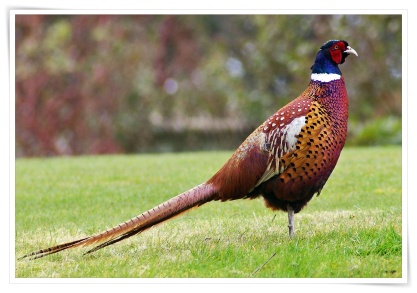
- Kingdom: Animalia
- Phylum: Chordata
- Class: Aves
- Order: Galliformes
- Family: Phasianidae
- Genus: Phasianus
- Species: colchicus
- English Name: Common Pheasant/Ring-necked Pheasant
- Scientific Name: Phasianus colchicus
- Distribution:: Afghanistan; Armenia; Azerbaijan; China; Georgia; Iran, Islamic Republic of; Kazakhstan; Korea, Democratic People's Republic of; Korea, Republic of; Kyrgyzstan; Lao People's Democratic Republic; Mongolia; Myanmar; Russian Federation (Eastern Asian Russia); Taiwan, Province of China; Tajikistan; Turkmenistan; Uzbekistan; Viet Nam
- General Description :
The common pheasant (Phasianus colchicus) is a bird in the pheasant Family (Phasianidae). It is native to Asia and parts of Europe like the northern foothills of the Caucasus and the Balkans. It is also known as the Ring-necked pheasant. It is a well-known gamebird, among those of more than regional importance perhaps the most widespread and ancient one in the whole world. - Size: 60 – 89 cm (Adult), Female: 50 – 63 cm (Adult)
- Weight: : Male: 1.2 kg (Adult), Female: 900 g (Adult).
- Food in Zoo: Seeds/ Paddy, Pulse, Grains, Chopped Spinach.
- Sexual Maturity: 8-12 months
- Incubation Period: 24-25 days
- Average Life Span: 3 years (In wild), 11-18 years (In captivity)
- Conservation Status:IUCN : Least Concern (LC) CITES: Not ListedWPA 1972: Not Listed
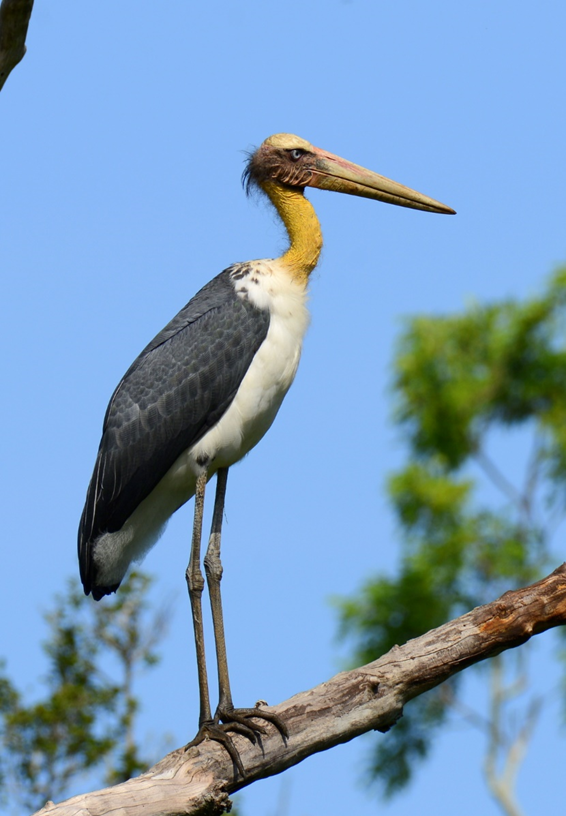
- Kingdom: Animalia
- Phylum: Chordata
- Class: Aves
- Order: Ciconiiformes
- Family: Ciconiidae
- Genus: Leptoptilos
- Species: javanicus
- English Name: Greater Adjutant
- Scientific Name: Leptoptilos javanicus
- Distribution: Bangladesh; Brunei Darussalam; Cambodia; India; Indonesia; Lao People's Democratic Republic; Malaysia; Myanmar; Nepal; Sri Lanka; Thailand; Viet Nam
- General Description :
Very large stork, dark grey-black above, white below, with naked head and neck. Non-breeders have mostly yellowish head and neck skin with vinous-tinged head sides and contrastingly pale forehead. Breeding males show coppery spots on median coverts, narrow whitish edges to lower scapulars, tertials and inner greater coverts and redder head sides. Juvenile is duller and less glossy above, with more down on head and neck. Similar spp. It is however more closely associated with wetland habitats where it is solitary and is less likely to scavenge than the related greater adjutant. It is a widespread species found from India through Southeast Asia to Java. - Size:length of 87–93 cm (34–37 in)
- Weight:4-6 kg
- Food in Zoo: Fish, chicken.
- Incubation Period: 28-30 days.
- Average Life Span: 30 – 40 years
- Conservation Status:IUCN : Vulnerable (Vu) CITES: Not ListedWPA 1972: Schedule IV
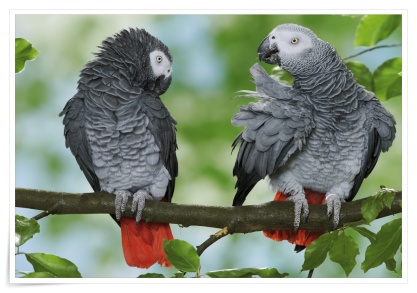
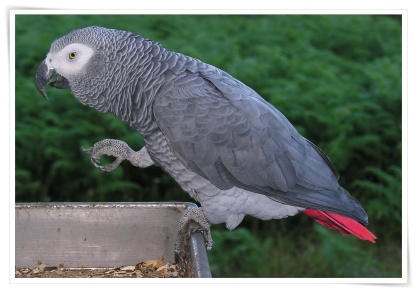
- Kingdom: Animalia
- Phylum: Chordata
- Class: Aves
- Order: Psittaciformes
- Family: Psittacidae
- Genus: Psittacus
- Species: erithacus
- English Name: Grey Parrot
- Scientific Name: Psittacus erithacus.
- Distribution: Angola; Burundi; Cameroon; Central African Republic; Congo; Congo, The Democratic Republic of the; Côte d'Ivoire; Equatorial Guinea; Gabon; Ghana; Kenya; Nigeria; Rwanda; Sao Tome and Principe; Tanzania, United Republic of; Uganda
- General Description :
The grey parrot also known as the Congo grey parrot, Congo African grey parrot or African grey parrot, is an Old World parrot in the Family Psittacidae. It has darker grey than its body over the head and both wings. The head and body feathers have slight white edges. The tail feathers are red. Both sexes appear similar. The colouration of juveniles is similar to that of adults, but typically their eyes are dark grey to black - Size: 33 cm
- Weight: 418-526 gm
- Food in Zoo: Fruits
- Sexual Maturity: 3-5 years
- Incubation Period: around 30 days
- Average Life Span: 15-23 years (Wild) and 40-60 years (Captivity)
- Conservation Status:IUCN : Endangered (EN) CITES: Appendix IWPA 1972: Not Listed


- Kingdom: Animalia
- Phylum: Chordata
- Class: Aves
- Order: Pelecaniformes
- Family: Ardeidae
- Genus: Nycticorax
- Species: nycticorax
- English Name: Black-crowned Night-heron
- Scientific Name: Nycticorax nycticorax
- Distribution:The black-crowned night heron is distributed in Asia, Indian Subcontinent, Africa, Europe and Americas.
- General Description :
The Black-crowned night heron (Nycticorax nycticorax) is a medium-sized heron found throughout a large part of the world. These birds have a stocky appearance as if hunched over, the head tucked down into the shoulders, and they are usually seen with this posture. They are most active at dusk or at night when their ghostly forms fly from their daytime roosts to the wetlands where they forage. - Size: The night herons are medium-sized herons, 58–65 cm,.
- Weight: 727-1014 gm).
- Food in Zoo: Fish.
- Sexual Maturity: 1 years.
- Incubation Period: 24 to 26 days.
- Average Life Span: about 20 years
- Conservation Status:IUCN : Least Concern (LC) CITES: Not ListedWPA 1972: Not Listed


- Kingdom: Animalia
- Phylum: Chordata
- Class: Aves
- Order: Pelecaniformes
- Family: Ardeidae
- Genus: Ardea
- Species: cinerea
- English Name: Grey Heron
- Scientific Name: Ardea cinerea.
- Distribution:Presence in India : Grey Heron is mostly found in the State of Haryana in India.Also grey herons occur in most parts of Europe, Asia, and Africa.
- General Description :
The grey heron is a long-legged predatory wading bird of the heron Family, the plumage of the Grey heron is largely ashy-grey above, and greyish-white below with some black on the flanks. Adults have a head and neck white with a broad black supercilium that terminates in the slender, dangling crest, and bluish-black streaks on the front of the neck. - Size: 84 – 100 cm.
- Weight: 1 – 2.1 kg.
- Food in Zoo: Fish.
- Sexual Maturity: 1 years.
- Gestation Period: 25 days.
- Average Life Span: 5 yrs.
- Conservation Status: Least Concern IUCN : Least Concern (LC)
CITES: Not ListedWPA 1972: Not Listed
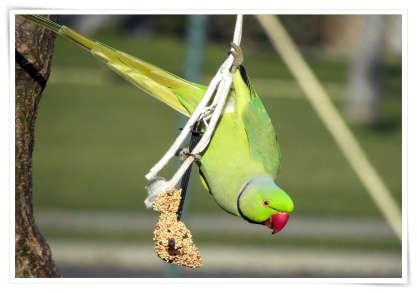
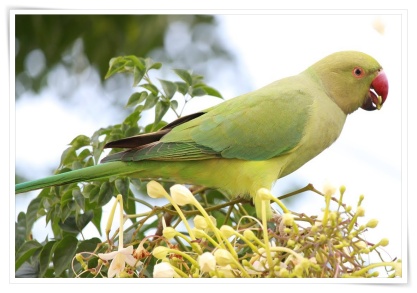
- Kingdom: Animalia
- Phylum: Chordata
- Class: Aves
- Order: Psittaciformes
- Family: Psittacidae
- Genus: Psittacula
- Species: krameri
- English Name: Rose-ringed Parakeet
- Scientific Name: Alexandrinus krameri.
- Distribution:Afghanistan; Bangladesh; Benin; Bhutan; Burkina Faso; Cameroon; Central African Republic; Chad; China; Côte d'Ivoire; Djibouti; Eritrea; Ethiopia; Gambia; Ghana; Guinea; Guinea-Bissau; India; Liberia; Mali; Mauritania; Myanmar; Nepal; Niger; Nigeria; Pakistan; Senegal; Sierra Leone; South Sudan; Sri Lanka; Sudan; Togo; Uganda; Viet Nam.
- General Description :
The rose-ringed parakeet (Psittacula krameri), also known as the ring-necked parakeet, is a medium-sized parrot in the Genus Psittacula, of the Family Psittacidae. These parakeets are also capable of living in a variety of climates outside their native range and are able to survive low winter temperatures in Northern Europe. The species is not threatened, but its popularity as a pet and unpopularity with farmers have reduced its numbers in some parts of its native range. - Size: 38-42 cm in length including the tail feathers.
- Weight: about 130-137 grams
- Food in Zoo: Ripe Banana, Guava Apple, Chana Sattu, Sunflower seeds..
- Sexual Maturity: 3 year..
- Incubation Period: 23-24 days..
- Average Life Span: 25-30 years
- Conservation Status:IUCN : Least Concern (LC) CITES: Appendix IIWPA 1972: Schedule IV

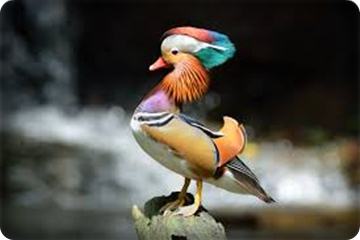
- Kingdom: Animalia
- Phylum: Chordata
- Class: Aves
- Order: Anseriformes
- Family: Anatidae
- Genus: Aix
- Species: galericulata
- English Name:Aix galericulata
- Scientific Name: Aix galericulata.
- Distribution:China; Japan; Korea, Republic of; Extant (breeding): Korea, Democratic People's Republic of; Russian Federation (Eastern Asian Russia); Extant (non-breeding):Taiwan, Province of China
- General Description :
The adult male has a red bill, large white crescent above the eye and reddish face and "whiskers". The male's breast is purple with two vertical white bars, and the flanks ruddy, and he has two orange "sails" at the back (large feathers that stick up like boat sails). The female is similar to the female wood duck, with a white eye-ring and stripe running back from the eye, but is paler below, has a small white flank stripe, and a pale tip to its bill. - Size: 41-49 cm
- Weight:444-500 gm
- Food in Zoo: Seeds/ Paddy, Pulse, Grains, Chopped Spinach
- Sexual Maturity: around 1 year
- Incubation Period: 30 Days.
- Average Life Span: 6-10 years
- Conservation Status:IUCN : Least Concern (LC) CITES: Not Listed
WPA 1972: Not Listed

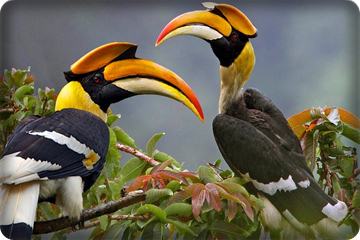
- Kingdom: Animalia
- Phylum: Chordata
- Class: Aves
- Order: Bucerotiformes
- Family: Bucerotidae
- Genus: Anthracoceros
- Species: albirostris
- English Name:Oriental Pied Hornbill
- Scientific Name: Anthracoceros albirostris
- Distribution:Bangladesh; Bhutan; Brunei Darussalam; Cambodia; China; India; Indonesia; Lao People's Democratic Republic; Malaysia; Myanmar; Nepal; Singapore; Thailand; Viet Nam
- General Description :
The most distinctive feature of the hornbills is the heavy bill, supported by powerful neck muscles as well as by the fused vertebrae. The large bill assists in fighting, preening, constructing the nest, and catching prey. A feature unique to the hornbills is the casque, a hollow structure that runs along the upper mandible. In some Species it is barely perceptible and appears to serve no function beyond reinforcing the bill. - Size: Male 70-85 cm and Female 60-65 cm.
- Weight: Male 680-907 gm and female 500-879 gm
- Food in Zoo: Ripe Banana, Papaya, Apple, Chana Sattu, Sunflower Seed
- Sexual Maturity: 4-5 years.
- Incubation Period: 25-33 Days.
- Average Life Span: about 40-50 Years
- Conservation Status:IUCN : Least Concern (LC) CITES: Appendix II
WPA 1972: Schedule I


- Kingdom: Animalia
- Phylum: Chordata
- Class: Aves
- Order: Struthioniformes
- Family: Struthionidae
- Genus: Struthio
- Species:camelus
- English Name: Common Ostrich
- Scientific Name: Struthio camelus.
- Distribution:Today ostriches are only found natively in the wild in Africa, where they occur in a range of open arid and semi-arid habitats such as savannas and the Sahel, both north and south of the equatorial forest zone.
- General Description :
Resident and locally common. Inhabits all types of forest with dense undergrowth and thickly overgrown steep gullies, usually not far from water. Males are rather variable depending on the subspecies involved, but all have an at least partially glossy bluish-black plumage, while females are overall brownish. Both sexes have a bare red face and greyish legs . - Size: 1.7 to 2.0 m (5 ft 7 in to 6 ft 7 in) tall..
- Weight:63 to 145 kilograms (139–320 lb).
- Food in Zoo: Poultry feed, Seasonal Fruits, Chopped Spinach, Chopped Cabbage.
- Sexual Maturity: 2 to 4 years.
- Incubation Period: 35- 45 Days.
- Average Life Span: 40 to 45 Years.
- Conservation Status:IUCN : Least Concern (LC) CITES: Appendix I
WPA 1972: Not Listed
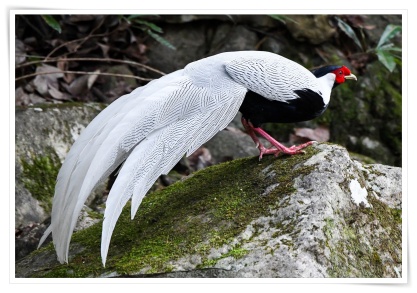

- Kingdom: Animalia
- Phylum: Chordata
- Class: Aves
- Order: Galliformes
- Family: Phasianidae
- Genus: Lophura
- Species: nycthemera
- English Name: SILVER PHEASANT
- Scientific Name: Lophura nycthemera
- Distribution:South-western China, eastern Myanmar, southern Vietnam, southwestern Cambodia, southeastern Thailand, northern Laos and the island of Hainan.
- General Description :
The male silver pheasant is immediately identifiable by his white back and tail with thin black bars, his red facial wattles, black crest and black underbody. The female is brown with smaller facial wattles and a small black crest. Both males and females have bare, red legs. - Size: Male 120 to 125 cm (47 to 49 in), including a tail up to 75 cm (30 in),
Females 55–90 cm (22–35 in), including a tail of 24–32 cm (9.4–12.6 in) - Weight: Male 1.13–2.00 kg (2.49–4.41 lb),
females 1.0–1.3 kg (2.2–2.9 lb). - Food in Zoo: Poultry Feed, Pulse Grain, Paddy, Garlic, Chopped Spinach.
- Sexual Maturity: 1-2 years.
- Incubation Period: 26 to 27 days
- Average Life Span: 15 to 20 years on average
- Conservation Status:IUCN : Least Concern
CITES: Not Listed
WPA 1972: Not Listed

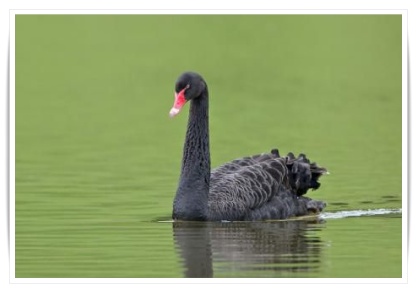
- Kingdom: Animalia
- Phylum: Chordata
- Class: Aves
- Order: Anseriformes
- Family: Anatidae
- Genus: Cygnus
- Species: atratus
- English Name:Black Swan
- Scientific Name: Cygnus atratus
- Distribution:Australia; New Zealand, Spain, Indonesia
- General Description :
Black swans are mostly black-feathered birds, with white flight feathers. The bill is bright red, with a pale bar and tip; and legs and feet are greyish-black. Cobs (males) are slightly larger than pens (females), with a longer and straighter bill. Cygnets (immature birds) are a greyish-brown with pale-edged feathers.. - Size:measures between 110 and 142 centimetres (43 and 56 in) in length.
- Weight: 3.7–9 kilograms (8.2–19.8 lb).
- Food in Zoo: Pulse, Grains,Poultry Feed, Paddy, Chopped Spinach.
- Sexual Maturity: 2 years.
- Incubation Period: 30 to 40 days..
- Average Life Span: 30 to 40 years
- Conservation Status: IUCN : Least Concern (LC) CITES: Not Listed
WPA 1972: Not Listed


- Kingdom: Animalia
- Phylum: Chordata
- Class: Aves
- Order: Anseriformes
- Family: Anatidae
- Genus: Cygnus
- Species: melancoryphus
- English Name: Black-necked Swan
- Scientific Name: Cygnus melancoryphus
- Distribution:The Black-necked Swan breeds in Chilean Southern Zone, Patagonia, Tierra del Fuego and on the Falkland Islands. In the austral winter, this Species migrates northwards to Paraguay, Bolivia and southern Brazil.
- General Description :
Black–necked swan (Cygnus melancoryphus) have an elevated hind toe, a thin coat of feathers, and pointed wings. The legs are pink, very short and have unusual positioning, making it hard for these swans to walk on land. The black-necked swan is the largest waterfowl native to South America. - Size: Adults average 102 to 124 cm (40 to 49 in).
- Weight: 3.5 to 6.7 kg (7.7 to 14.8 lb).
- Food in Zoo: Seeds/ Paddy, Pulse, Grains, Chopped Spinach
- Sexual Maturity: 2 years.
- Incubation Period: 34 to 37 days.
- Average Life Span: 20 to 30 years.
- Conservation Status:IUCN : Least Concern (LC) CITES: Appendix II
WPA 1972: Not Listed
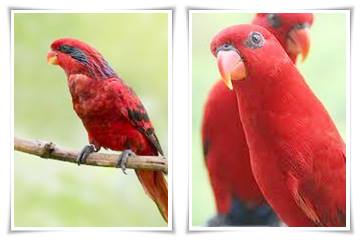
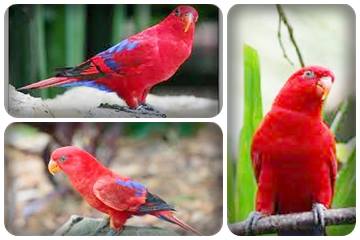
- Kingdom: Animalia
- Phylum: Chordata
- Class: Aves
- Order: Psittaciformes
- Family: Psittacidae
- Genus: Eos
- Species: bornea
- English Name: Red Lory
- Scientific Name: Eos bornea
- Distribution:The red lory in particular is endemic to the Moluccas and surrounding islands in Indonesia
- General Description :
The red lory (Eos bornea) is a Species of parrot in the Family Psittaculidae. It is the second most commonly kept lory in captivity, after the rainbow lorikeet. It is mostly red and the plumage of the upper body is all red. There are red, blue, and black marks on the back and wings, and the tail is reddish-brown with blue under-tail coverts. The beak is orange and the legs are grey.
The male and female have identical external appearance. - Size: about 31 cm in length.
- Weight: 156-170 grams.
- Food in Zoo:Fruits(Mango, Papaya, Banana), Paddy, Chopped Spinach.
- Sexual Maturity: 18 – 24 months.
- Incubation Period: 21-25 days.
- Average Life Span: 20 to 30 years.
- Conservation Status:IUCN : Least Concern (LC) CITES: Not Listed
WPA 1972: Not Listed

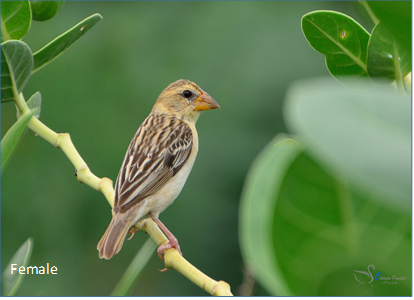
- Kingdom: Animalia
- Phylum: Chordata
- Class: Aves
- Order: Passeriformes
- Family: Ploceidae
- Genus: Ploceus
- Species: philippinus
- English Name: BAYA WEAVER
- Scientific Name: Ploceus philippinus
- Distribution:Bangladesh; Cambodia; China; India; Indonesia; Lao People's Democratic Republic; Malaysia; Myanmar; Nepal; Pakistan; Sri Lanka; Thailand; Viet Nam
- General Description :
The Baya weaver (Ploceus philippinus) is a weaverbird best known for the elaborately woven nests constructed by the males. These birds spend their time in flocks and build their nest near water or place them hanging over water where predators cannot reach easily. Weavers vary drastically in color, shape, and size, and within the Family, researchers recognize over a hundred different Species! Many Species are small, stout, and finch-like, but each is different from the next. Their plumage, or feathers, comes in a wide range of colors, including white, black, red, yellow, brown, tan, orange, and everything in between. - Size: about 15 cm in length.
- Weight: 18-28 grams.
- Food in Zoo:Seeds/ Paddy, Pulse, Grains, Chopped Spinach
- Sexual Maturity: 4 to 6 months.
- Incubation Period: 14 – 17 days.
- Average Life Span: about 5 years
- Conservation Status:IUCN : Least Concern (LC) CITES: Not Listed
WPA 1972: Schedule IV
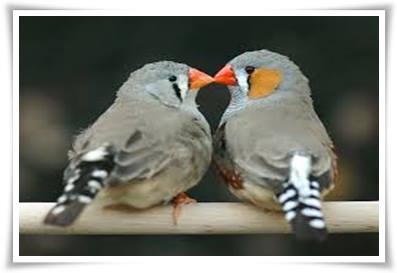
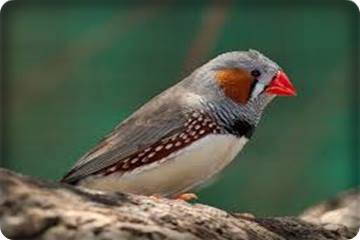
- Kingdom: Animalia
- Phylum: Chordata
- Class: Aves
- Order: Passeriformes
- Family: Estrildidae
- Genus: Taeniopygia
- Species: guttata
- English Name: Timor Zebra Finch
- Scientific Name:Taeniopygia guttata
- Distribution:Zebra Finches are the most common and widespread of Australia’s grassfinches, found across the Australian mainland, with the exception of Cape York Peninsula and some coastal areas. They are also found in Timor and the Lesser Sunda Islands.
- General Description :
Zebra Finches are mainly grey, with characteristic black ‘tear drop’ eye stripes and ‘zebra like’ black and white barring on the rump and upper tail. The male is distinguished from the female by its chestnut cheek patches, a character that gave the Species the alternative name of Chestnut-eared Finch. - Size: about 10-11 cm in length.
- Weight: 12 grams.(Adult)
- Food in Zoo:Paddy, Pulse, Grains, Chopped Spinach
- Sexual Maturity:2-3 months.
- Incubation Period: 12 – 15 days.
- Average Life Span: 2- 5 years.
- Conservation Status:IUCN : Least Concern (LC) CITES: Not Listed
WPA 1972: Not Listed
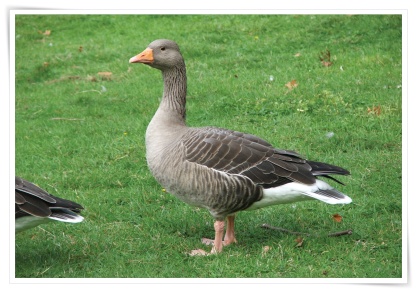
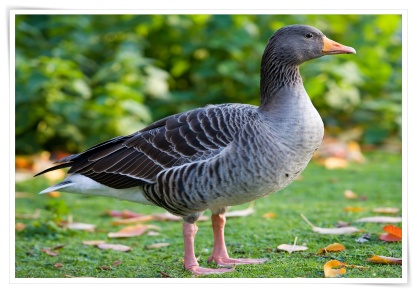
- Kingdom: Animalia
- Phylum: Chordata
- Class: Aves
- Order: Anseriformes
- Family: Anatidae
- Genus: Anser
- Species: anser
- English Name: Greylag Goose
- Scientific Name: Anser anser.
- Distribution:Europe, West and South Asia and South Australia
- General Description :
The greylag goose (Anser anser) is a Species of large goose in the waterfowl Family Anatidae and the type Species of the Genus Anser. It has mottled and barred grey and white plumage and an orange beak and pink legs. Greylag geese travel to their northerly breeding grounds in spring, nesting on moorlands, in marshes, around lakes and on coastal islands. They normally mate for life and nest on the ground among vegetation. A clutch of three to five eggs is laid; the female incubates the eggs and both parents defend and rear the young. - Size: 74-91 cm
- Weight: 2.16 – 4.56 kg
- Food in Zoo:Seeds/ Paddy, Pulse, Grains, Chopped Spinach
- Sexual Maturity: around 3 years
- Incubation Period: about 28 days
- Average Life Span: around 23 years
- Conservation Status:IUCN : Least Concern (LC) CITES: Not Listed
WPA 1972: Not Listed
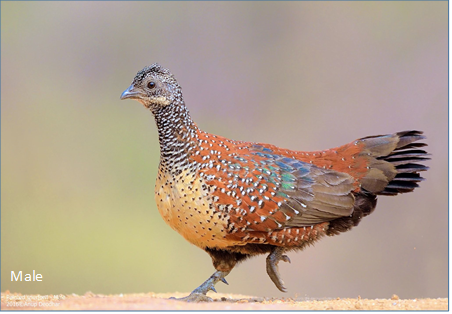
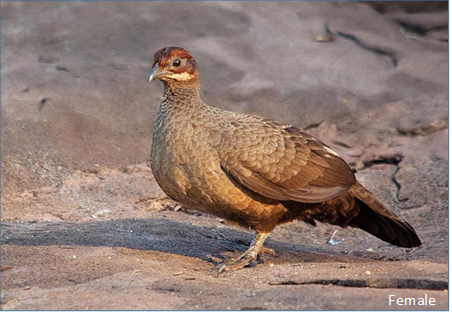
- Kingdom: Animalia
- Phylum: Chordata
- Class: Aves
- Order: Galliformes
- Family: Phasianidae
- Genus: Galloperdix
- Species: lunulata
- English Name: Painted Spurfowl
- Scientific Name: Galloperdix lunulata
- Distribution:India
- General Description :
The painted spurfowl is a bird of the pheasant Family found in rocky hill and scrub forests mainly in peninsular India. Males are more brightly coloured and spotted boldly in white. Males have two to four spurs while females can have one or two of the spurs on their tarsus. The Species is found mainly in rocky and scrub forest habitats unlike the red spurfowl. It is found in the undergrowth in pairs or small groups, escaping by running and rarely taking to the wing when flushed. - Size: 27-34 cm
- Weight: 226-285 gm
- Food in Zoo:Poultry Feed, Paddy, Pulse, Grains.
- Sexual Maturity:2-3 years
- Incubation Period:27-28 days
- Average Life Span: around 11 years
- Conservation Status: Threatened IUCN: Least Concern (LC)
CITES: Not Listed
WPA 1972: Schedule IV

- Kingdom: Animalia
- Phylum: Chordata
- Class: Aves
- Order: Strigiformes
- Family: Tytonidae
- Genus: Tyto
- Species: alba
- English Name: Barn Owl
- Scientific Name: Tyto alba
- Distribution:Europe, Asia, Africa, Oceania, North America, South America.
- General Description :
The Barn owl (Tyto alba) is the most widely distributed species of owl in the world and one of the most widespread of all species of birds. This owl does not hoot but utters an eerie, drawn-out screech. The head and upper body typically vary between pale brown and some shade of grey in most subspecies. Some are purer, richer brown instead, and all have fine black-and-white speckles except on the remiges and rectrices (main wing and tail feathers), which are light brown with darker bands. The heart-shaped face is usually bright white, but in some subspecies it is brown. - Size: 29-44 cm,Wingspan: 68-105 cm
- Weight:220-700 gm
- Food in Zoo:Chicken
- Sexual Maturity:10-11 months
- Incubation Period:30 days
- Average Life Span: 4-34 years
- Conservation Status: Threatened IUCN: Least Concern (LC)
CITES: Appendix III
WPA 1972: Schedule I

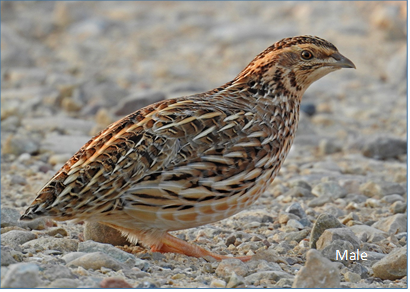
- Kingdom: Animalia
- Phylum: Chordata
- Class: Aves
- Order: Galliformes
- Family: Phasianidae
- Genus: Coturnix
- Species: Coturnix
- English Name: Quail
- Scientific Name: Coturnix coturnix
- Distribution:It is also found in some parts of the north eastern regions of India like Sikkim, Bihar and parts of Assam. The Japanese quail is found in East Asia. Being migratory in nature, the wild Japanese quail is available in Manchuria, south-eastern Siberia, northern Japan, and the Korean Peninsula.
- General Description :
The Common quail (Coturnix coturnix) is a small ground-nesting game bird in the pheasant family Phasianidae. With its characteristic call, this species of quail is more often heard than seen. The Quail, also called “bater” in Hindi, is a small type of bird known as backyard chicken. However, only two Species of quail are popular in India; the black-breasted jungle or rain quail found in jungle and the brown-coloured Japanese quail which is bred for meat or used for commercial purposes. - Size: It measures roughly 18.0–21.9 cm (7.1–8.62 in).
- Weight: 91–131 g (3.2–4.62 oz).
- Food in Zoo:Pulse, Grains, Poultry Feeds, Paddy, Chopped Spinach
- Sexual Maturity: 8-9 weeks.
- Incubation Period: 17-18 days.
- Average Life Span: 2 – 3 years.
- Conservation Status:IUCN : Least Concern (LC) CITES: Appendix II
WPA 1972: Not Listed
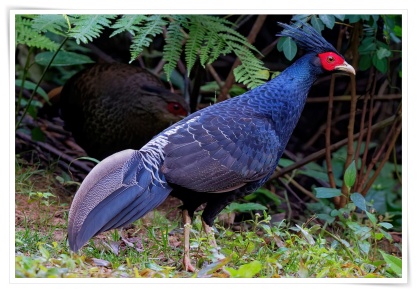
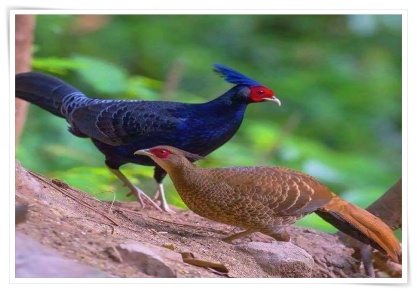
- Kingdom: Animalia
- Phylum: Chordata
- Class: Aves
- Order: Galliformes
- Family: Phasianidae
- Genus: Lophura
- Species: leucomelanos
- English Name: KALIJ PHEASANT
- Scientific Name: Lophura leucomelanos
- Distribution:In India – in the northwestern, western , central and eastern Himalayas (Jammu and Kashmir , Himachal Pradesh, Uttarakhand, Sikkim, Arunachal Pradesh and northern West Bengal )usually 2,700m and in the hills of northeast India (Assam, Meghalaya, Manipur, Meghalaya, Mizoram, Nagaland &Tripura).
- General Description :
Resident and locally common. Inhabits all types of forest with dense undergrowth and thickly overgrown steep gullies, usually not far from water. Males are rather variable depending on the sub Species involved, but all have an at least partially glossy bluish-black plumage, while females are overall brownish. Both sexes have a bare red face and greyish legs. - Size: ranging in length from 63-74 cm (25 to 29 inches).
- Weight: 795-1150 gm
- Food in Zoo:Poultry Feeds, Paddy, Pulse, Grains,Galic , Spinach
- Sexual Maturity:1-2 years.
- Incubation Period:24-25 Days.
- Average Life Span: In Wild 8-12 years and In Captivity 15-16 Years.
- Conservation Status: Threatened IUCN: Least Concern (LC)
CITES: Appendix III
WPA 1972: Schedule I
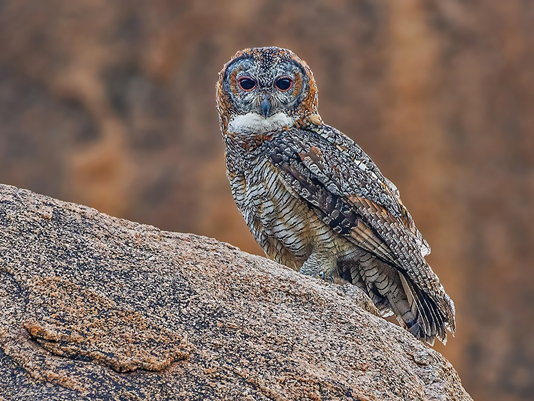
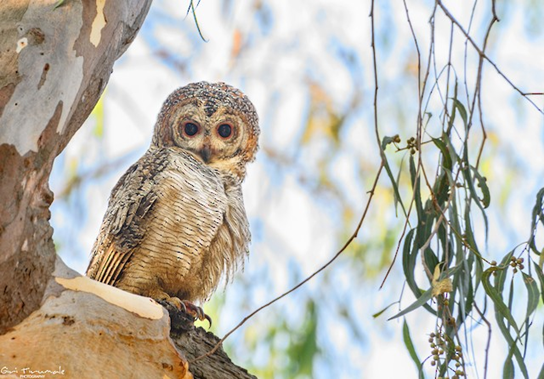
- Kingdom: Animalia
- Phylum: Chordata
- Class: Aves
- Order: Strigiformes
- Family: Strigidae
- Genus: Strix
- Species:ocellata
- English Name: Mottled Wood-Owl
- Scientific Name: Strix ocellata
- Distribution:India
- General Description :
The mottled wood owl (Strix ocellata) is a species of large owl found in India. They are found in gardens and thin deciduous forests adjacent to dry thorn forests or farmland. They are easily detected by their distinctive tremulous eerie calls at dawn and dusk. The characteristic call is a duet of the male and female while other notes include a low hoot and a screech. Their large size, lack of "ear" tufts and the concentric barring on the face make them easy to identify - Size: 41-48 cm, Wingspan: 31-37 cm
- Weight:220-700 gm
- Food in Zoo:Chicken
- Sexual Maturity:1-3 years
- Incubation Period:35 days
- Average Life Span: 10-20 years
- Conservation Status: Threatened IUCN: Least Concern (LC)
CITES: Appendix III
WPA 1972: Schedule I

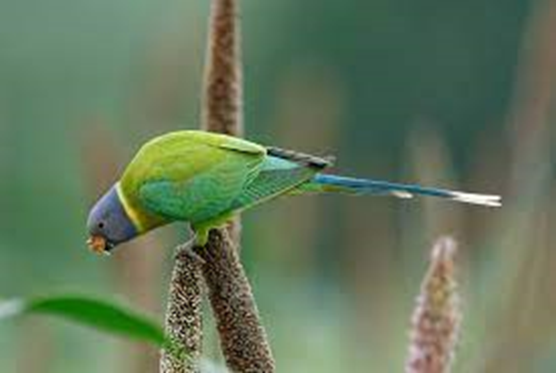
- Kingdom: Animalia
- Phylum: Chordata
- Class: Aves
- Order: Psittaciformes
- Family: Psittacidae
- Genus: Himalayapsitta
- Species:cyanocephala
- English Name: Plum-headed Parakeet
- Scientific Name: Psittacula cyanocephala
- Distribution:India, Bangladesh, Nepal, Sri Lanka, Pakistan
- General Description :
The plum-headed parakeet (Psittacula cyanocephala) is a parakeet in the family Psittacidae. It is endemic to the Indian Subcontinent and was once thought to be conspecific with the blossom-headed parakeet (Psittacula roseata) but was later elevated to a full species. Plum-headed parakeets are found in flocks, the males having a pinkish purple head and the females, a grey head. They fly swiftly with twists and turns accompanied by their distinctive calls. - Size: 30-33 cm in length including the tail feathers.
- Weight:about 80-85 grams
- Food in Zoo:Ripe Banana, Guava Apple, Chana Sattu, Sunflower seeds.
- Sexual Maturity:3 years.
- Incubation Period:19-23 days.
- Average Life Span: 20-22 years
- Conservation Status: Threatened IUCN: Least Concern (LC)
CITES: Appendix II
WPA 1972: Schedule IV


- Kingdom: Animalia
- Phylum: Chordata
- Class: Aves
- Order: Columbiformes
- Family: Columbidae
- Genus: Spilopelia
- Species: chinensis
- English Name: SPOTTED DOVE
- Scientific Name: Spilopelia chinensis
- Distribution: Indian subcontinent, parts of West Asia, Central Asia and parts of Southeast Asia.This Species had a large natural distribution from Britain and Ireland to northern Africa, across Europe, Arabia, Central Asia, India, the Himalayas and up into China and Mongolia
- General Description :
The spotted dove (Spilopelia chinensis) is a small and somewhat long-tailed pigeon that is a common resident breeding bird across its native range on the Indian subcontinent and in Southeast Asia. The Species has been introduced to many parts of the world and feral populations have become established. - Size: ranging in length from 28-32 cm (11.2 to 12.8 inches)
- Weight: about 160 gm.
- Food in Zoo: Bird Mesh, Chopped Spinach, Several Fruits
- Sexual Maturity: about 6 months
- Incubation Period: 13-17days.
- Average Life Span: 8-10 years
- Conservation Status: IUCN : Least Concern (LC) CITES: Not Listed
WPA 1972: Schedule IV

